#Persian Scimitar
Explore tagged Tumblr posts
Text
instagram
✨KOA Exclusive – Persian Shamshir / Scimitar✨
🗡️Back by popular demand! Kult of Athena has a limited stock available of this classic Windlass sword which we commissioned Windlass to produce for us in a special production run🗡️
The Persian Shamshir is a recreation of this iconic sword of the Middle East – this saber is not only light and nimble, but the curved blade is optimized for decisively deep cutting and quick slashes and in skilled hands the sword is a surprisingly capable piercing weapon which can strike its target at unpredictable angles. The hilt has a comfortable grip of well-polished wood with an enlarged pommel which neatly couches against the back of the hand for a sure grip. The crossguard is made from metal with an antiqued silvered finish and the blade tang is dual-riveted into the grip for a solid overall construction.
#Kult of Athena#KultOfAthena#videos#Instagram#Persian Shamshir#Persian Scimitar#Scimitars#Shamshirs#sword#swords#weapon#weapons#blade#blades#KOA Exclusive#Middle Eastern Indian & N. African Swords#Middle Eastern Indian & N. African Weapons#Battle Ready#1065 High Carbon Steel#Windlass Steelcrafts#Middle Eastern Swords#Middle Eastern Weapons
2 notes
·
View notes
Note
okay i know that you said you're not the greatest history buff, but i realy wanted to know your take on the Safavid kingdom as a representation of a middle eastern community..? if you've read enough manhwas you probably have seen some stupid stereotypes and it realy sucks. god i feel like i'm bothering you asking this i mean we don't know much about safavid .. you don't have to answer this :D
of course! i'll try my best to speak about it! the floor is also open to anyone who has their own additions!
So. We all know that ASM borrows inspiration from existing territories and conflict from the 1700s all the way up to the late 1800s, right? Well get ready for this.
If we use this same research model, we'll come to find that the Safavid Dynasty also existed in Iran back in the 16th century. Which means we have a direct reference point we can compare the (manhwa) Safavid Kingdom to! (just remember to take it with a few grains of salt. We're dealing with 400+ years of history here!)
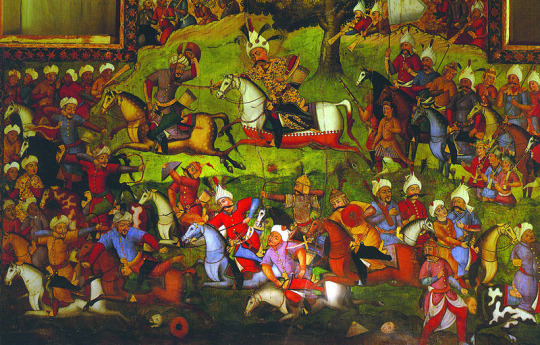
In my humble opinion (as someone who isn't part of the middle-eastern community btw), I feel like ASM does a pretty fair job at representing the middle east via Safavid/Pasha Family. The biggest hurdle just comes from the fact we haven't seen much of them yet.
The first thing I noticed was the architecture. During Halima's trip back home to Safavid we get to see ORKA's depiction of the Kingdom. As you can see below, the inspiration behind the Bahjat's Palace is pretty directly linked to the Meidan Emam in Isfahan, a royal mosque from the Safavid Era!

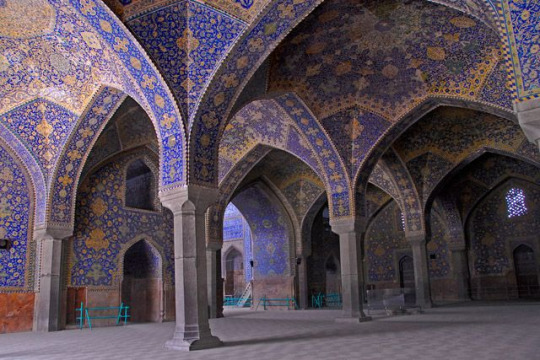


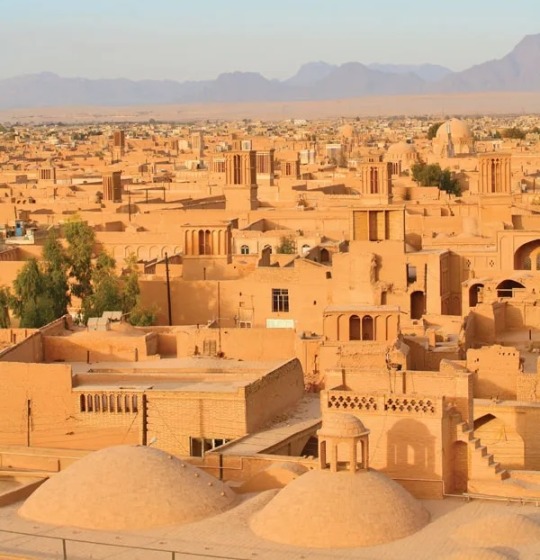
Unfortunately, the establishing shot of the city isn't as easy to compare, with the introduction of modern architecture. But if we look at Yazd, an untouched city in Iran, we can see the traces of inspiration with just a few minor discrepancies: minaret, domed mosques, earthen town houses.
We also get these small fleeting moments that really make the characters feel like they're from another country. For example, Nasir, Ali's escort can be seen wielding a curved sword as opposed to a European broadsword. Later, Nora mentions that it is a shamshir, a type of Persian scimitar.

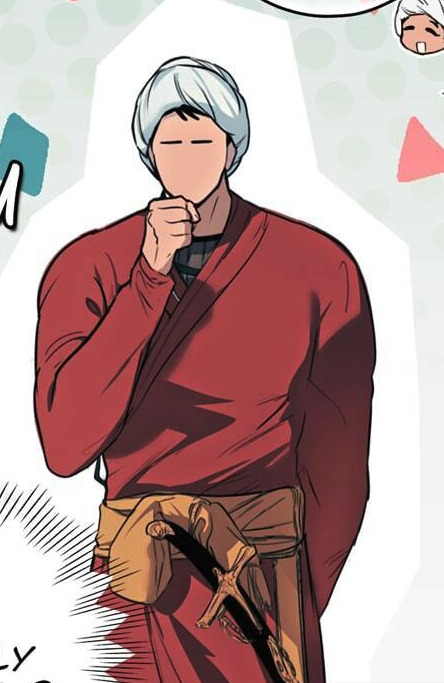
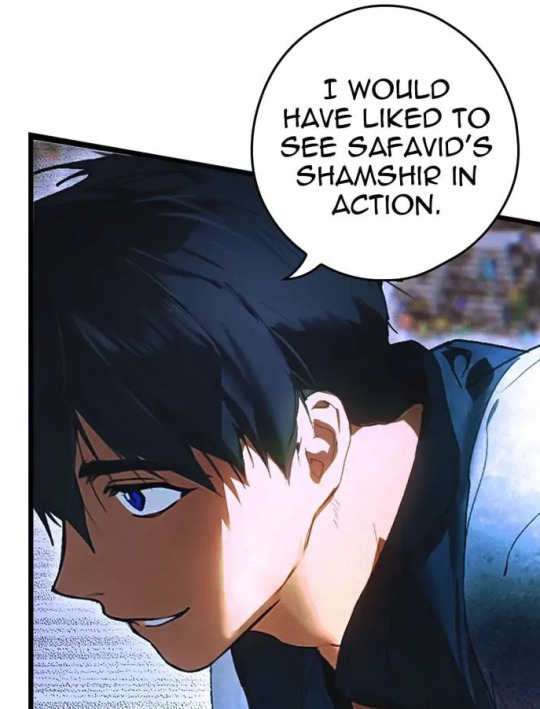
even these small details really make for great world building. Honestly, I'd love to see these props make a comeback in future scenes. Like can you imagine seeing one of the rugs Ali brought in the Neuschwanstein Castle?
Now to finally get to the part you've probably been waiting for. The clothes.

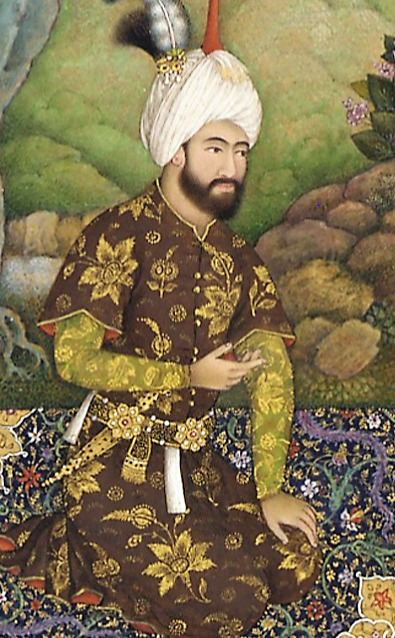
Unfortunately, I'm not as well versed in royal fashion in the Middle East so I had a hard time identified the style of dress.
When we compare the real Shahs of the Safavid Dynasty, we'll see that their fashion of choice changed greatly over the course of the ruling. I couldn't pinpoint exactly who, when or which specific culture ORKA is referencing here. But we do see some elements from Tahmasp I (feathered turban, ornate belt, embroidered textiles). Please correct me if I've made any errors here. I'm totally not confident in my Middle Eastern fashion history.
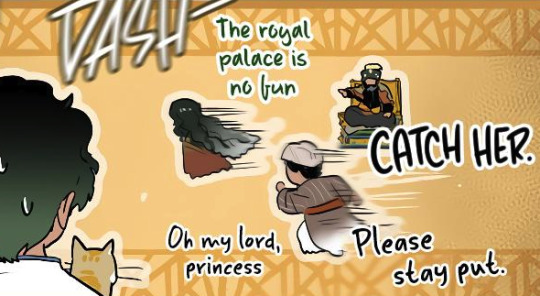
But above all else, I really just enjoy how the Pasha family is written and designed. I think we've seen stereotypes in all forms of media where middle easterners are portrayed... not so well.
In ASM, they're just the Pashas. As a foreign kingdom, they pose a threat against the Empire, but they're not evil. The King seems to be as tired with Halima's bullshit as the Empress is with Theo. Even Nasir has his own occasional dialogue, exasperated by Ali's behavior. And if you've read the same comics I have, we're all too familiar with the "dangerous and stoic middle-easterner" stereotype.
IMO, we've seen "foreign" characters in manga/manhwa that are usually boiled down to one of three types: the socially insensitive clowns/perverts, the murderer, or the alien that somehow has white skin and hair. but I personally find it a breath of fresh air how ASM leans full into the concept of darker skinned characters with dark hair and actual rounded personalities.
This shouldn't be such a high bar to reach, but ORKA has one again reached it.
#a stepmother's marchen#the fantasie of a stepmother#ali pasha#halime pasha#stepyapping#askstepmarchen
34 notes
·
View notes
Text
The sword of the day is the shamshir.

There are several kinds of Persian scimitar, and this is one of them. It features a particularly strong curve, which makes it an effective cutting weapon. As a light and fast one-handed weapon, the large pommel is not just for looks; that curve helps the wielder to retain control of the blade.
71 notes
·
View notes
Text
After looking at several possible references for what could Vlad’s kılıç look like, I finally made up my mind and crafted a particular idea. Therefore, let me introduce you to Vlad’s weapon of choice:

Even though the general rule on how to differentiate between the Turkic and Persian scimitars is that the Persian shamshir has that perfect deep curve while the Ottoman kılıç is straighter and has a flaring tip near the end of the blade, even these two can be mistaken for one another because they might be curved to a varying degree or with a less pronounced tip. However, Vlad’s kılıç is definitely one of the finest Ottoman works, showcasing the mastery of sword-making of that time.
Therefore, his would have the perfect, standard shape — the slightly curved and broader handle to fit his grip nicely, a straight blade that curves upwards into the wider yalman (the flared tip). It has a single edge except for the yalman which is double-edged, allowing to harm the opponent by a flick. I do think his yalman would be much more pronounced than it is on the picture, maybe something like this. I also think the guard would be wider, for his own comfort.
The Ottoman sword-making was pretty famous for personalisation of the blades — the owners usually had quotes from Qur’an on them, Mehmed’s ceremonial sword is a good example of that (more on his sword soon!). Because Vlad was not a Muslim, he obviously wouldn’t have that, but I still think he would have a soft pattern engraved on the steel, something like on the picture above. He definitely values practicality, so the pattern would be more on the subtle side.
Despite having inherited his father’s two-handed sword (allegedly made from the finest Toledo steel and given to him by King Sigismund), Vlad prefers the Ottoman kılıç over any of the European swords. This reason is a very practical and pragmatic one — because he was raised by the Turks from his ten years and spent time there until he turned eighteen (with roughly ten months of that period being back in Wallachia), a period during which he was most intensely trained for fighting, he simply grew accustomed to the Ottoman way of fighting and use of weapons. Unlike the Europeans, the Ottomans had a very dynamic fighting style in terms of movement, and their weapons were an extension of that fluidity.
The physical training is what he always enjoyed greatly, and so he naturally picked up the style he was rigourously trained in. When he becomes an active warrior, that is the type of fighting that comes naturally to him, like an instinct. Kılıç is the weapon he is accustomed to and is masterful at wielding — whenever he tries to train with a straight two-handed sword, it feels clumsy in his hands and slows down the instinctive fluidity he needs in his movement.
#( battle plans )#( oc: if i cannot move heaven i will raise hell )#kılıç his beloved#also i love this because it shows he is not an invincible war machine good with hundreds of weapons#he is unstoppable with what he is good at and does not gamble with flashy displays#he sticks to what he trusts so that he kills well and does not get killed
4 notes
·
View notes
Note
I quite like swords, do you have any fun facts on them
(Axes are fine too)
Well, since I already did a whole post on Axes, which you can read here:
I might as well do my due diligence and info dump on my knowledge of swords so ... I should have expected this but here we go:
A Brief (lmao not at all) Overview of a Complicated Sword History
by an autistic trans girl demon
So before we get started, first we have to understand the categorization of swords. What we know as a "sword" is a general term from Old English deriving from the word "Sweord", meaning a "long bladed weapon with a handle and sometimes a hilt that is designed to stab, hew, cut, or slice; this means if it was clearly designed not to stab, hew, cut, or slice, and doesn't have an arbitrarily "long" blade, it's not a sword. Secondly, a lot of historical sources really only focus on swords as weapons, not tools, and thus we have an issue where tools that fall under the same description of swords won't typically be called swords but classified as "this other totally not a sword thing". Thirdly, swords were a slow development from daggers, which were classified loosely as double edged blades of a knifes size. If you're not following yet, this classification doesn't apply to all long-bladed creations and rarely do we get accounts of their use as tools because of this. That is, unless, you start looking at the few tools that became swords. And additionally, we have to remember that other cultures had definitions for tools, weapons, and items that crossed over or into what the English defined as a "sword" meaning that the "sword" category starts getting messy real quick. This simply isn't as clean as "wedge-on-a-stick" (axe) or "short sharp thing with handle" (knife). And rather than define what is a sword by it's common definition, it's actually better to look at what has become classified as a "sword" despite not quite meeting the definition initially defined as "a long double bladed weapon with a handle and sometimes a hilt" and those creations that should be classified as swords but aren't.
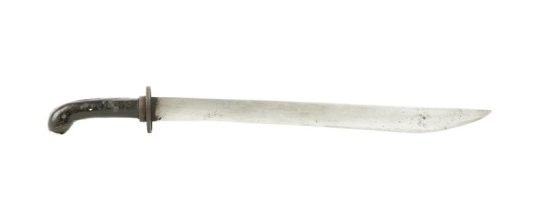
Which we begin the "sword-enough" category in China with the Dao. The above image is the Duan Dao. Dao are single edged long bladed weapons that showed up somewhere in 1600 to 1050 B.C. during the Shang Dynasty period but gained popularity as a cavalry sword much later. There are many types of Dao, each classified by their blade length, blade type, handle length, etc. and had strict requirements for construction. It was used like a sword, but only had one edge, so we called it a sword despite it's cousin the Dao phased out, the Jian, actually fitting the initial "sword" description perfectly.
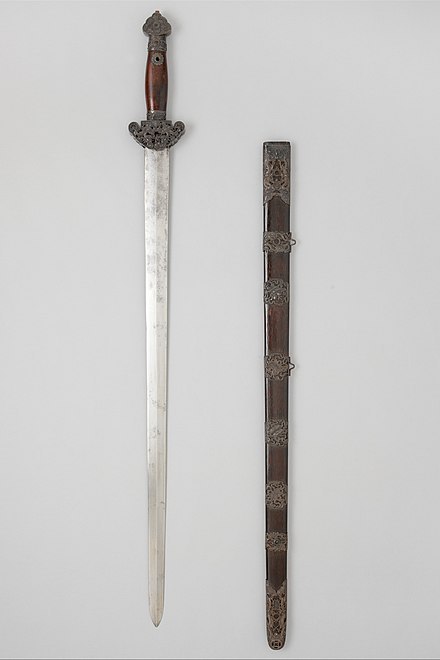
A version of a Jian for reference.
But I can hear it coming: isn't a Dao just a Sabre? And sure, the image I showed LOOKS like a Sabre, but thats because of the Dao's complex history and how it evolved over time. It at one time looked like this:
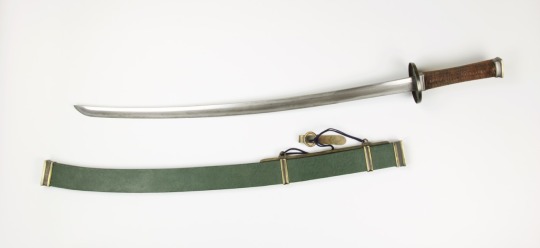
Which is a Wodao, a variant if the Dao that looked and often had very close similarities to another "shouldn't be a sword but is" creation from a different country. That is, the one edged blade known as ...
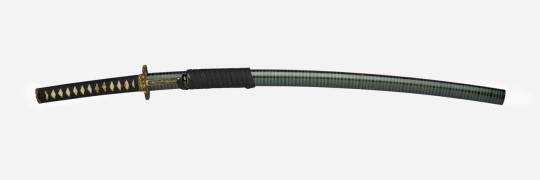
The Katana. But oh wait, this is actually part of a series! See out of all the "swords that shouldn't be swords" from Japan, the Katana has a shorter cousin, the Wakizashi, which is slightly smaller in blade and hilt, and the Tanto which should be a knife, but somehow squeezed itself in. All of these weapons have specific requirements to their construction to be called what they are from blade and tang length, to steel folding requirements, etc. but all have one thing in common: they've only got one edge. And next up from another edge of the world is ...
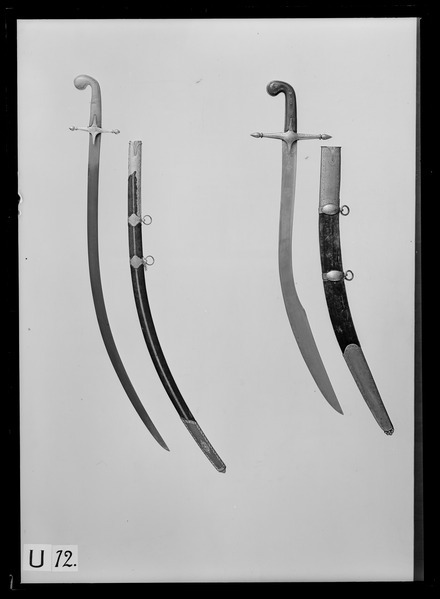
The Scimitar. A bastardization of the Persian word Shamshir, which is an entire classification of swords with curved blades that some Sabres, Dao, and at one point Katana's were all classified as. This category of one bladed swords is massive and includes weapons from North Africa to the Middle East to some areas in Europe. And is this rants segway into the tools category, starting with dancing swords. Now bear with me because I don't have a photo for this one; just a rant. While sword dancing began as training exercises for many cultures, it became entertainment and from it birthed a subcategory of unbladed swords that were flimsier, more flexible, and less likely to cut you. Unlike dancing with axes where the most that was done at best was a blunting of the blade, dancing swords aren't able to be resharpened to be weapons but are rather "tools" of entertainment. Despite not being bladed at all, or intended to stab, cut, hew, or slice, they look like swords and thats enough to call them swords. But want to know who doesn't get this treatment?
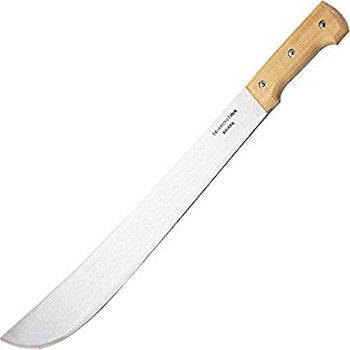
The Machete. Tanto gets to squeeze in on sword, but this is just a "long bladed knife". It's history is supposedly grounded in South America as a bush clearing and harvesting tool. But it's a tool, not a weapon, and thus in it's own class. Another familiar face stuck in it's own class is ...
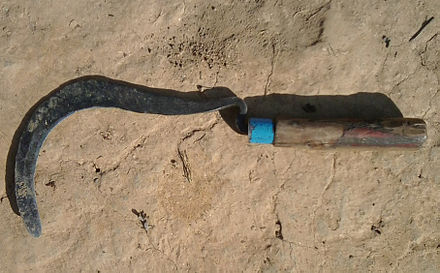
The Sickle. Now theres MANY types of sickles, many sizes, several could be "swords" by the way we include one-bladed creations. But alas, it's not a weapon, thus not a sword, unless it IS a weapon in which it IS a sword, a "sickle sword" or ...
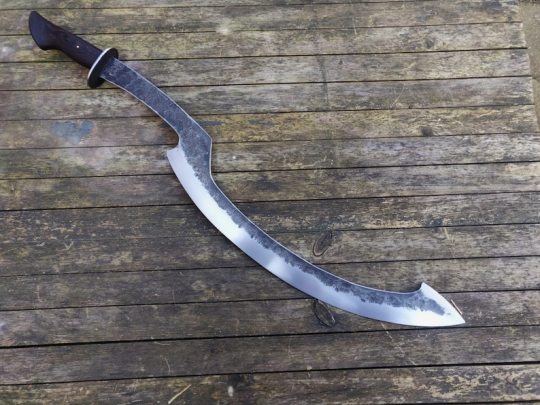
A Khopesh. But oh crap, a sickle that is a sword? A tool used both for combat, harvest, and a trade tool? Thats only 1/3 sword! What can we do to preserve our obviously pristine and infalliable "sword" categorization? Answer: call it "Sickle Shaped".
Look, I don't know how to end this besides saying that I do genuinely love swords. They've been coming of age gifts, presents for achievements, badges of honour, and in many cultures, like my ancestors, a symbol of love and unity. The very act of driving a sword deep into a pole to see how far it would go in as a "sign" of how long a marriage could last was part of some germanic/viking culture. Swords are awesome. But the classification and what we do and don't consider a sword is arbitrary, hypocritical, and stupid.
Go buy a sword for a loved one. The classification apparently doesn't matter so just make sure it looks "sword enough" and no one can argue with you.
#talisidekick#talisidekick things#swords#sword history#sword rant#not where I thought this was going but yeah: swords#trans#transgender#mtf#talisidekick rants
15 notes
·
View notes
Text
plotted starter for @hatredcurse
There were cops and there was Fugaku, unlike others he was a jerk every single time. He was the bridge between state cops and outside special forces. The detectives and cops who worked under Shisui went on scenes when nothing else worked and when state jerks like Fugaku could not solve crimes or fix their own messes. And there he was. Fugaku sitting across Shisui with that always dull facial expression now angry one fuming almost.
"Shisui you are a hellspawn you know that! I am telling you to..." and there he goes exploding into authority that he thought he had here.
"Of course, I am, we were born to become hellspawns. We all sin and earn that place one way or another. " Shisui replied cutting Fugaku in the middle of his tirade. Was Shisui religious? No one was sure about that, he always had a silver chain around his neck with a small cross. Slowly Shisui's gaze shifted from his empty cup of coffee to Fugaku, Shisui's voice was emotionless even the tone of his voice was indifferent, and his cop face was on while he listened. And to be frank he thought that Fugaku was overreacting.
Foresincs was still there in the house where the murder was committed. According to Fugaku, it's a horror show inside, to which Shisui just rolled his eyes and lit his next cigarette. The car of the victim was parked outside a white Mercedes, on the left side it was damaged. If Shisui didn't know better he would say it was claw marks of some beast. He touched and the split edges were sharp, it was done with some blade a curved blade like a scimitar. That was nothing new, some killers liked to leave a mark or to vandalize the property of their victims. Plus if the killer knew the victim it could also be a personal revenge.
Never before Shisui was glad that he had to examine the crime scene at nightfall, somehow darkness dulled all the red of the blood. The first body was outside between two pine trees between the roots. This time Shisui didn't roll his eyes. Whole his career he had never seen anything like this. This was like the work of a butcher. Have you ever seen how a butcher cuts up a pig and takes out all the insides wash and you have your meat. This was just messy, blood-coathed the grass and the trunks of pine trees. The head was still there horror of what happened to the man was evident frozen there forever. The main cut went from the base of the neck to the groin. From that point, the body was opened like a closet and the killer picked which clothing to take and which to leave. The heart was gone, lungs, kidneys, spleen he was cleaned out, only his cock was left to which Shisui had to chuckle when he regained his senses.
"I guess you pissed off the wrong woman she took all but left you with your pride" Skin was removed too, leaving the pink flesh of muscles revealed to the world, only his neck and head were untouched, his guts were taken and left to the left side of his body like a coiled snake just this one was full of shit.
Inside of the house was a female victim, the blood inside was more visible under the artificial lights. It was brown and thick and almost dry over the walls and over the rich Persian carpet. Inside there were more cops the one in charge was a tall piece of work. Looking at a dead woman with a cold collected demeanor. Shisui had no chance to speak because Fugaku did it for him.
"This is Kazuo the one who leads this investigation and this is Shisui he will help you get to the bottom of this"
Shisui just sighed looking at the taller man, damn he was tall almost like a pine tree, if a serial killer meets him he will for sure shit his pants.....
#modern au#shisui uchiha#present time#which verse is this?#i will figure it out later#warning#blood#victims#violence#and all that
2 notes
·
View notes
Text
“Cast your gaze between Mount Sion and the Temple; look on that other little tribe who live separated from the rest of the inhabitants of the city. Ever a particular object of contempt, they bow their heads without complaint; they suffer every indignity without demanding justice; they allow themselves to be overwhelmed with blows without a groan; if their heads are required, they present them to the scimitar. If any member of this proscribed society dies, his companions will bury him secretly, at night, in the Valley of Jehoshaphat, in the shadow of the Temple of Solomon. Penetrate the dwelling places of that people, and you will find them in abject poverty, reading a mysterious book to their children which will be read, in turn, to their children. What they performed five thousand years ago, this race still performs. Seventeen times they witnessed the fall of Jerusalem, yet nothing can discourage them from turning their eyes toward Zion. When one sees the Jews dispersed throughout the earth, according to the word of God, one is indeed surprised; but to be struck by supernatural astonishment, one must encounter them again in Jerusalem; one must see the legitimate rulers of Judea, slaves and foreigners in their own country: one must see them still awaiting, despite all oppression, a king who will deliver them. Persians, Greeks, Romans, have disappeared from the earth, and a little tribe, whose origin antedates that of those great peoples, still lives without admixture among the ruins of its country. If anything, among the nations, possesses the character of a miracle, that character, I believe, is here.”
-François-René de Chateaubriand, 1806 - 1807
#jumblr#history#jerusalem#quotes#israel#palestine#took out two lines one irrelevant and one antisemitic (in the religious sense)
4 notes
·
View notes
Text

Haradrim Cavalryman - by TurnerMohan
"Southward beyond the road lay the main force of the Haradrim, and there their horsemen were gathered about the standard of their chieftain. And he looked out, and in the growing light he saw the banner of the king, and that it was far ahead of the battle with few men about it. Then he was filled with a red wrath and shouted aloud, and displaying his standard, black serpent upon scarlet, he came against the white horse and the green with great press of men; and the drawing of the scimitars of the Southrons was like a glitter of stars.
Then Theoden was aware of him, and would not wait for his onset, but crying to Snowmane he charged headlong to greet him. Great was the clash of their meeting. But the white fury of the Northmen burned the hotter, and more skilled was their knighthood with long spears and bitter. Fewer were they but they clove through the Southrons like a fire-bolt in a forest. Right through the press drove Theoden Thengel's son, and his spear was shivered as he threw down their chieftain. Out swept his sword, and he spurred to the standard, hewed staff and bearer; and the black serpent foundered."
ROTK chapter 6: The Battle of the Pelennor Fields
Of all the designs in the lord of the rings movies, the "evil" men in service to Sauron were a bit of a disappointment to me, mostly because I got the sense alot of their design process was hampered by the requirement not to offend anyone, so whereas the gondorians got to draw from all this long history of beautiful italian art, and the rohirrim were ancient anglo saxons almost to the letter, the invading men from the south and east just kind of ended up looking like mishmashed videogame villains. I suppose I can understand the necessity; phrases like "the white fury of the northmen" are among Tolkien's more shall we say uncomfortable lines, at least for modern tastes, but this design is alot closer to what was in my head while reading the books. the costume is drawn mostly from arabic and turkish armor with a little ancient persian and rajput thrown in for good measure
5 notes
·
View notes
Text

I only had to be asked once—
Marta’s rapier and dagger are standard issue Second House, and Jody carries an identical one. The hilt is based on modern naval standard issue rapiers and the pommel is red anodized steel rather than a more frivolous stone or design. The entire weapon is hard metal. Two lines mark the house on the ricasso.
Naberius’s weapons are form over function, and I went out of my way to make it look painful to hold (after all, the Princesses regularly eat him) every element from the precious stones to the filigree basket come in three, but the third spike on the knuckle guard breaks off from the other two. Made of gold, enamel, and a gold-washed steel blade both weapons are meticulously engraved with even further small details that were hard to render at this scale. The dagger is based on split parrying daggers, sometimes called trident gauches of the Renaissance.
For Jeannemary, there are elements of the standard issue as the fourth is extremely militaristic like the second, but has a blue cabochon in both hilts and wrapped leather and cord hilt. The basket on the rapier and partying loop on the dagger reflect the fourths talents fkr wards and Jeannemary’s relationship to Magnus. It is the smallest rapier on the board because she is just 14 and looking at it in scale makes me sad (which makes it a good design choice). Four lines down the ricasso show the house, and including the cross guard there are four horizontal elements to the basket.
Magnus’s blade I designed as a wedding or anniversary gift from Abigail, based on old books about Celtic love knots and necromantic theory about interwoven souls. Each flat band of filigree is engraved with their vows or necromantic theorems. It has brown carved and inlaid cabochons on each pommel and brown leather wrapped hilt for comfort. The blade is white steel.
Cam’s twin blades are based on Turkish scimitars and Persian kukris, but in a sleek all metal form reflective of the Sixth’s functional vibes. The only decorative marks are the three lines on each blade totaling 6. The swords are smaller allowing for Cam’s aggressive and effective fighting style. The heavy metal pommels are super effective for bludgeoning whoever she needs to.
Protesilaus one ups Babs with form over function, with a copper washed rapier with elaborate filigree sweepings in loops, swirled, and vines. There’s a carved and inlaid jade hilt on both weapons with designs a mishmash of ocean and floral Greek, Chinese, and art deco motifs. The chain is based on Chinese weapons called kau sin ke, with the weight shaped after a flower bud.
I’m stark contrast is Colum’s straight forward rapier and sidearm based on medieval Templar weapons and simple rapiers. The small shield is between a targe and a buckler. The cruciform details repeat, I think John just reused the cross as his own symbol when rebuilding his church. Unlike the other rapiers, it is more like a short sword with a long fuller.
Finally, Gideon Nav’s mass produced two handed sword with a perfunctory leather wrapped hilt and basic machined metal pommel. The pommel is similar in shape to the pommels on the second and fourth rapiers. It is in dark steel, reflecting the Ninth house. Despite its huge function in the story, it is the most basic shaped weapon with no decoration in hard contrast to the overblown decoration of other ninth custom made weapons (I imagine Ortus’s was wild with skulls and bones!) I gave it a concave ricasso to make it more separate from the rapiers.
Let me know if there’s anything specific you want info on that I didn’t hit!

Blades of the Cavalier Primaries Displayed for your Appreciation
In house order from top to bottom. I’d be happy to explain the choices if anyone is interested!
8K notes
·
View notes
Text
instagram
Persian Shamshir from @kult_of_athena Review!
video via sellsword.arts
#Kult of Athena#KultOfAthena#sellsword.arts#videos#Instagram#Persian Shamshir#Persian Scimitar#Scimitars#Shamshirs#sword#swords#weapon#weapons#blade#blades#KOA Exclusive#Middle Eastern Indian & N. African Swords#Middle Eastern Indian & N. African Weapons#Battle Ready#1065 High Carbon Steel#Windlass Steelcrafts#Middle Eastern Swords
2 notes
·
View notes
Text
From Registration to Results: A Step-by-Step Guide to Online PTE Success in Dubai
Embarking on the journey to conquer the Pearson Test of English (PTE) can seem as ambitious as scaling the Burj Khalifa. The skyline reflects the city’s ambitious educational goals, and enrolling in online PTE classes in Dubai offers a comprehensive roadmap to mastering this English language test. This guide not only walks you through the registration process but also escorts you straight to the moment you triumphantly access your results.

Step 1: Decoding the online PTE classes in Dubai
Picture the online PTE classes in Dubai as a four-part symphony, each section (speaking, writing, reading, and listening) a movement that tests your linguistic skills in a high-stakes academic environment. Begin by immersing yourself in the test’s structure, question types, and scoring nuances. Understanding these elements is like having a map in hand before embarking on a desert safari—it’s essential!
Step 2: Selecting Your Guide
Just as you’d choose a knowledgeable desert guide, picking the right educational provider in Dubai is crucial. Seek out institutions famed for their:
Sage Instructors: These are the mentors with a knack for transforming complex English language nuances into comprehensible lessons.
Rich Learning Materials: Opt for courses packed with detailed study guides and an arsenal of practice tests.
Real-Time Test Simulations: Engage in mock exams that mimic the natural test environment for online PTE classes in Dubai. You can contact professional services for PTE Exam Fees in Cairo.
Adaptable Schedules: Ensure the course fits your personal and professional life like a tailored Arabian robe.
Step 3: Enlisting for the Journey
Signing up is your official commitment to conquer the online PTE classes in Dubai :
Navigate to your chosen provider’s digital oasis (website) and select your course.
Fill out the virtual parchment (registration form) and transfer your digital coins (make a payment).
Await the magical seal of enrollment (confirmation email) that grants you access to the treasure trove of learning materials.
Step 4: Diving into the Oasis of Knowledge
Active engagement in your course is akin to diving deep into the calm waters of an oasis:
Participate fully in all live sessions, as each one is a stepping stone to mastering the English language.
Complete all assignments with the diligence of crafting a fine Persian carpet.
Utilise extra resources such as one-on-one tutoring as if they were rare spices that enhance the flavour of your preparation.
Step 5: Navigating Through Feedback
Regular assessments and feedback are your compass in the desert of preparation:
Cherish the feedback like rare desert rain, using it to nurture your growing skills.
Identify oases (strengths) and mirages (weaknesses) to focus your efforts effectively.
Step 6: The Caravan to the Test Center
When ready, join the caravan (register) for the exam of online PTE classes in Dubai:
Select a date at a test centre as you would choose the perfect date for a desert star-gazing night.
Confirm your place under the constellation of test-takers.
Step 7: The Final Encampment
In the last few weeks before the exam, your preparation should intensify:
Revise like you are tracing the sands of time.
Engage in mock tests to sharpen your test-taking scimitar. For more details on PTE Exam Fees in Cairo, speak to experts in the field.
Step 8: The Day of the Test
On test day, approach the centre as if you were entering the gates of an ancient, revered fort:
Arrive early to acclimatise and adapt.
Follow the sage advice of the centre’s custodians and manage your resources (time) wisely.
Step 9: Unveiling the Scores
Retrieving your results is like finding the scroll of your fate:
Log into your portal to discover the treasures of your hard work.
Analyse your score as a merchant would his profits, determining where gains were made and where investments are still needed.
Step 10: Charting the Next Course
With scores in hand, navigate your next steps:
If satisfied, proceed like a victorious trader returning home.
If aiming higher, re-enlist for the journey, armed this time with the wisdom of experience.
Step 11: Linguistic Souk Visits
Imagine each language skill as a vibrant souk in Dubai. Create interactive virtual marketplaces where:
Each ‘stall’ offers different language challenges or puzzles.
Engage in barter-like exchanges where you trade solutions with peers, fostering a collaborative learning environment.
Step 12: The Tech Oasis
Incorporate Dubai’s pioneering tech landscape into your study:
Use augmented reality (AR) apps to visualise grammar rules and vocabulary in 3D, making complex language concepts straightforward and engaging.
Employ voice recognition software during speaking practices to get real-time feedback and pronunciation coaching, simulating a digital language tutor.
Step 13: Desert Island Discourses
Transform practice sessions into themed discourses set in various iconic Dubai landscapes:
Conduct speaking practices as if you’re leading a tour of the Burj Khalifa, explaining architectural features or history to an imaginary group of tourists.
For writing, imagine drafting press releases for the Dubai Media City, adapting your tone and style for different audiences and purposes.
Step 14: Mindful Mirage Reflections
Use the serene imagery of a desert mirage to practice mindfulness techniques:
Before each study session, visualise achieving your ideal score in online PTE classes in Dubai as a mirage that becomes a reality, setting a positive tone for learning.
Practice deep breathing exercises styled after the rhythmic waves of the Arabian Gulf to maintain calm and focus during test preparations.
Step 15: Festival of Achievements
Celebrate your preparation milestones with a festival-themed reward system:
Organise a virtual festival where each milestone achievement unlocks a new ‘event’—this could be a movie night, a special dinner, or an online concert.
Mirror the extravagance of Dubai’s shopping festivals by treating yourself to books, gadgets, or experiences that contribute to your learning or relaxation.
By navigating these steps, your expedition through the online PTE classes in Dubai will not only prepare you for the exam but also deepen your appreciation and command of the English language, serving you well in your academic and professional quests in Dubai and beyond. Embark on this journey with confidence and the spirit of adventure!
0 notes
Text
PRINCE OF PERSIA: THE LOST CROWN | GAMERS GUIDE REVIEW
The desert wind whispers through all of us, not just across my sun-baked skin, but into the bones. It carries the faintest echo of clanging scimitars and desperate leaps across impossible chasms. For a Prince of Persia fan, that’s more than just a breeze; it’s a battle cry, a siren song calling us back to a golden age of sand-dusted acrobatics and time-defying feats. The first time I scaled the Palace walls, fingers scrabbling for purchase on ancient brick. My heart echoed the Prince’s cocky bravado, each step a defiance against gravity and destiny. And the Sands of Time! To rewind a misstep, a brush with death, and try again, a dance with fate as exhilarating as it was terrifying.
Years have passed, kingdoms traversed, sandcastles built and washed away by the tide of new games. Yet, the Prince’s shadow lingers, a silhouette forever etched against the crimson sunset of a thousand afternoons spent glued to the screen. The parkour flows through my dreams, the witty banter a soundtrack to my imagination. Now, a new whisper ripples through the desert. The Last Crown gleams, a promise of untold adventure. My fingers twitch, yearning for the cold comfort of a scimitar hilt, the familiar weight of responsibility settling on our shoulders. But is it really a wow thing? Here’s my review of The Lost Crown:
The Last Crown is a 2024 action-adventure platformer game developed and published by Ubisoft. It is the latest installment in the Prince of Persia series, and it takes players on a journey through a mythical Persian world filled with danger and excitement.
Storyline:

Sargon, our newest hero, steps into the spotlight, not a prince by blood, but one forged in the fire of the Immortals, an elite warrior clan. His quest? To rescue Prince Ghassan from the clutches of the cursed city of Mount Qaf, a perilous journey echoing the classic hero’s call. But Sargon’s path is paved not just with blades and treacherous platforms, but with the intriguing twist of time manipulation. This ain’t your grandpa’s Sands of Time rewind. Here, we dance with echoes, crafting clones, slowing moments to a crawl, and even rewinding entire timelines. It’s a mind-bending ballet of combat and puzzle-solving, pushing the boundaries of what we thought possible in this beloved franchise.
Speaking of boundaries, The Last Crown breaks free from the linear corridors of the past. Sprawling, interconnected environments beg exploration, each biome boasting its own secrets and challenges. Sun-drenched deserts give way to verdant mountain valleys, crumbling ruins whisper forgotten lore, and the mythical Mount Qaf itself, a gravity-defying labyrinth, promises to redefine platforming as we know it.
But where are the familiar echoes of the past? Fear not, for the spirit of the series resonates in every leap and parry. The acrobatic combat is a symphony of steel and silk, each fluid movement a testament to Sargon’s skill. Witty banter punctuates the tension, reminding us of the Prince’s trademark charm. And those who still yearn for the Sands of Time will find echoes in the manipulation of time, albeit in a fresh, innovative form. So, is The Last Crown a mere retread of old glories? Absolutely not. It’s an evolution, a reinvention that honors the past while blazing a bold new trail. It’s a love letter to fans
Theme:

The central theme rests on Sargon’s journey of self-discovery. Thrust into the mantle of hero as an outsider to the royal lineage, he grapples with the expectations thrust upon him. Through his trials, he forges his own path, earning the respect of his comrades and ultimately defining his place in the world, not through inherited royalty but through his own courage and skill. This echoes the series’ enduring message: heroism can bloom in the most unexpected places. The concept of legacy casts a long shadow. The game explores the burden of living up to the deeds of ancestors, with Ghassan struggling under the weight of his royal legacy and Sargon navigating the expectations attached to the Immortals. It asks us to consider the complex relationship between history and personal choice, questioning whether we define ourselves by the achievements of the past or carve our own unique path.
Time itself becomes a thematic tool. The manipulation of echoes and timelines delves into the consequences of our actions, inviting us to contemplate the potential for change and the ripple effects of decisions. It raises questions about responsibility and regret, reminding us that every choice carries weight and shapes the tapestry of our own past, present, and future. However, a critical analysis reveals some cracks in the thematic facade. Sargon’s journey, while compelling, can feel derivative of previous Prince of Persia narratives, lacking the emotional depth of the Sands of Time trilogy. The exploration of legacy, while intriguing, sometimes gets overshadowed by the action-packed gameplay, and the consequences of manipulating time remain largely hypothetical, never truly impacting the narrative in a profound way.
Despite the shortcomings, The Last Crown’s thematic threads offer engaging food for thought. It invites us to ponder our own identities, the legacies we leave behind, and the power of our choices. While not universally groundbreaking, it provides a layer of depth beyond the acrobatic spectacle, enriching the experience for those who seek meaning beyond the thrill of the chase. Ultimately, The Last Crown’s themes are like an echo of the past, familiar yet with a distinct twist. It offers a thought-provoking exploration of identity and destiny, even if it doesn’t quite reach the emotional heights of its predecessors. It remains a worthy addition to the series, with its thematic core adding depth and resonance to the acrobatic adventure.
Gameplay:

Sargon’s movement is a joy to behold. He flows across rooftops with the grace of a dancer, scaling walls with effortless parkour precision. Wall runs, ledge grabs, and daring leaps weave into a symphony of skill, putting your platforming prowess to the test. Each successful maneuver feels like a reward, and mastering the intricate sequences becomes addictive. The game’s signature twist comes in the form of time manipulation. You can rewind moments, slow down time, and even create echoes of yourself to solve puzzles and overcome obstacles. This adds a layer of strategic depth, forcing you to think creatively and experiment with different temporal possibilities.
From swift parries to brutal takedowns, combat is a fast-paced ballet of steel. You wield swords, daggers, and even a bow, chaining together combos and utilizing Sargon’s special abilities to dispatch enemies. The combat system is responsive and rewarding, encouraging aggressive play while punishing reckless button mashing. The Last Crown embraces an open-world structure, allowing you to explore sprawling, interconnected environments at your own pace. Hidden secrets, collectible treasures, and optional side quests abound, rewarding exploration and encouraging meticulous scouring of every nook and cranny. Environmental puzzles weave seamlessly into the gameplay, testing your observation skills and understanding of time manipulation mechanics. They range from simple block-pushing to mind-bending temporal paradoxes, offering variety and keeping the pace fresh.
While the core gameplay elements feel familiar to Prince of Persia fans, The Last Crown introduces welcome innovations. The time manipulation mechanics are a breath of fresh air, and the open-world design offers unprecedented freedom. Yet, the game retains the spirit of the franchise, with acrobatic thrills and witty banter driving the experience. However, some caveats deserve mention. The open-world structure can feel repetitive at times, with some environments lacking the distinct personality of earlier Prince of Persia games. The combat, while fun, can get button-mashy in extended encounters, and the puzzles, while varied, don’t always reach the brain-bending complexity of previous titles.
Graphics:

The Last Crown paints a visual canvas, employing a vibrant, stylized art style that blends seamlessly with its mythical Persian setting. Here’s a closer look at its graphical flourishes:
The deserts bask in a warm, golden glow, emphasizing the rugged beauty of cracked canyons and windswept dunes. Lush oases offer a vibrant contrast, teeming with emerald greens and sapphire blues. Ancient ruins stand bathed in a mystical aura, their intricate carvings and towering structures whispered of a bygone era. Mount Qaf, defying gravity itself, is a feast for the eyes.
Sargon and his companions move with fluid grace, their armor and clothing rendered with meticulous attention to texture and design. Facial expressions are rich and expressive, bringing emotions to life during both intense combat and heartfelt conversations. Sunbeams pierce through dust motes, casting dramatic shadows across crumbling walls. Glowing waterfalls illuminate hidden caverns, while flickering torches dance in the night, creating an immersive atmosphere. Sand swirls in mesmerizing dances, magical energies crackle with vibrant hues, and shattered pottery fragments scatter with realistic physics. These details add a layer of depth and believability to the world.
The game embraces a stylized approach, with exaggerated silhouettes and vibrant colors reminiscent of Persian miniatures. This lends a unique charm to the visuals, setting it apart from the hyper-realistic aesthetic of many AAA titles. However, a graphical analysis wouldn’t be complete without acknowledging some potential drawbacks. While the stylized approach is beautiful, it may not appeal to everyone who craves gritty realism. Textures, while detailed in close-up, can appear blurry at times on certain platforms. And while the environments are diverse, some players might find them formulaic after venturing through several similar environments.
Know More
Originally Published at Gamer's Guide
0 notes
Text
Really? My immediate thought was Ancient Persian/Middle Eastern. Cause of the scimitar and clothing style


a new character (or not really, they kinda got recycled) for a new pathfinder mini campagne !
they are called Lucien, they are a nephilim fleshwarp cleric!
10K notes
·
View notes
Text
Exploring The Heritage Of The Arabian Scimitar Sword - The Saif
The Arabian scimitar sword, also known as the saif sword in Arabic, is a historical symbol of elegance, power, and prestige. Originating in the early Islamic era, it became warriors' preferred weapon.
This sword has an iconic curved shape and razor-sharp Arabic blades, making it a lethal weapon for skilled warriors. The detailed designs and expert craftsmanship of the Arabian Scimitar sword hold immense importance in Arabian heritage.
Today, many appreciate the artistry and culture associated with this Saif weapon, often displayed in museums or private collections. Exploring this sword's history offers insight into the ancient Arabian Peninsula and its inhabitants' lives. Join us on a journey of discovery into the captivating world of the Arabian sword and its cultural significance.
History Of The Arabian Scimitar Sword
There are many Middle Eastern sword types. Still, the Arabian Scimitar sword is a legendary weapon that has captured the imagination of many throughout history.
Dating back to the 9th century, this sword has a unique curved blade for cutting and thrusting.
The Arabian sword name "saif" is derived from the Arabic root "s-y-f," which means "to be sharp" or "to pierce.” This Arabic sword's name emphasizes its ability to cut and pierce through. Besides, the saif sword was originally used by warriors in the Middle East, particularly by Arab and Persian cavalrymen. The scimitar sword was later popularized by the Ottomans, who expanded their empire throughout the Middle East, Africa, and Europe. Its curved blade optimized cavalry combat, enabling swift cuts without sacrificing speed and momentum.
Earliest Known Evidence Of The Scimitar Sword
The oldest proof of the Arab straight sword or Saif sword dates back a long time ago. People in ancient lands used these curved swords for various tasks. They crafted these swords with care and skill, focused on their unique shapes.
Throughout history, warriors and leaders brandished these swords in battles, gaining power and respect. Besides, the Arabian Scimitar sword wasn't just a tool; it became a symbol of authority and honor. As time went on, the scimitar's design evolved, adapting to different needs and cultures. Even today, the legacy of the scimitar lives on, reminding us of the skills and traditions of our ancestors.
The Use And Evolution Of The Sword In History
Many ancient Arabic weapons, including the scimitar sword, have been used throughout history in various regions and periods. The most notable use of it was during the Crusades when it was wielded by Muslim warriors against Christian knights. Ottoman soldiers also used the sword during conquering the Middle East, Africa, and Europe.
In some regions, such as Persia, the sword became a symbol of royalty being passed down through generations of rulers. Despite its popularity, the scimitar sword eventually fell out of favor with the advent of gunpowder and modern warfare.
Battles That Featured The Arabian Scimitar Sword
One of the most iconic battles in which the Scimitar sword was wielded was the Battle of Tours in 732 AD. The Franks, led by Charles Martel, faced off against a Muslim army in southern France. The Muslim warriors were armed with a curved Arabian sword that struck fear into the hearts of their enemies. While the Muslim army succeeded early, the Franks emerged victorious, resulting in decreased Scimitar sword use in Europe. Nonetheless, the sword maintained popularity in the Middle East and beyond, featuring in events like the 1683 Siege of Vienna.
Iconic Features Of The Scimitar Sword
The Scimitar Sword is a curved, single-edged blade originating in the Middle East. It features a distinct and graceful curve that varies from blade to blade, sometimes extending to three-quarters of the sword's length. The blade is relatively narrow, typically measuring between one and two inches wide, and is characterized by a sharp tip. It is most commonly constructed from steel, with the best quality swords made from highly valued Damascus steel.
Key Design Elements Of The Sword
The Arabian Scimitar Sword has special designs that make it unique. Some key things about it are the curved blade, long hilt, and special pommel. The hilt is the part you hold and is covered with materials like leather or silk. These coverings come in beautiful designs that show how well the sword is made. In addition, the Arabian Scimitar sword boasts a distinctive and prominent feature in the form of its elegantly curved blade. This curvature allows substantial tactical advantages that are of paramount importance on the battlefield. The graceful arc of the blade enhances the sword's operational versatility, granting its wielder greater spectrum of motion and control. The degree of forethought that went into its design is indicative of a deliberate intention to optimize its efficacy for combat. Moreover, the pommel, discreetly positioned at the basal extremity of the hilt, is a pivotal component. It is characterized by its rounded contour serving as a functional enhancement to the sword's grip and manipulation.

How Its Construction And Shape Make It An Effective Weapon
The Scimitar Sword's curved shape makes it an effective weapon in various situations, especially in combat. The sword's curve allows users to generate more force with each swing, making it a particularly deadly weapon. Additionally, the narrow shape of the blade allows for greater speed and precision, making it easier to strike with accuracy. Its distinctive shape also allows users to draw it quickly in a fight, making it a preferred weapon for close-quarter.
Fascinating Facts And Myths About The Sword
The Scimitar Sword carries fascinating facts and myths with it. In Middle Eastern culture. However, it is believed to be a sacred weapon with the power to ward off evil spirits. It was also reputed to possess mystical and magical properties and was often used during religious ceremonies. The Scimitar Sword's origin can be traced back to ancient Persia in the 15th century. It was a popular weapon used by the Persian cavalry. Also, it was used throughout the Ottoman Empire and was a favored weapon of the Janissaries. Today, the Scimitar Sword continues to be featured in popular movies, video games, and literature, making it a beloved weapon.

Scimitar's Role In Middle Eastern Heritage
The Arabian Scimitar sword is paramount in Middle Eastern heritage, integral to the region's rich history. This iconic Arabic blade has been deeply intertwined with the cultural and historical tapestry of the Middle East for centuries. Its distinctive design, curved blade, and single sharp edge are instantly recognizable and synonymous with the region's traditional weaponry. Symbolizing power, the scimitar has been wielded by leaders and warriors for prestige across history. The sword's role in battles remains ingrained in Middle Eastern memory, leaving an indelible mark. From Persia to the Ottoman Empire, the scimitar has aided conquest and defense, embraced by diverse cultures. Moreover, the scimitar holds a deeper meaning within Middle Eastern society beyond its practical use in combat. It represents honor, courage, and chivalry, embodying the values that have shaped the region's cultural identity. Passed down through generations, the scimitar has become a cherished heirloom, connecting families and preserving their traditions.
The Scimitar's Usage Beyond Warfare
While the scimitar's reputation as a formidable weapon in warfare is well-known, its usage extends far beyond the battlefield. The versatility of this sword is highlighted by its role as a symbolic ceremonial item across the Middle East. The Scimitar, one of the ancient Arabic weapons, takes center stage in traditional ceremonies, symbolizing honor, strength, and preserving tradition. It is often used in ceremonial dances and performances, adding historical significance to the festivities. Furthermore, the scimitar has found its place in decorative arts. Intricately designed scimitars are often displayed as ornamental pieces adorning the walls of homes and cultural institutions. These beautiful swords are a testament to the region's rich heritage and artistic prowess, captivating locals and visitors alike.
Scimitar's Representation Across Various Forms Of Expression
The scimitar's allure extends beyond its physical presence and permeates literature, art, and pop culture. In stories, poems, and novels, the scimitar represents heroism, adventure, and the captivating mystique of the East. Artists and artisans have also been captivated by the scimitar's aesthetic appeal. Paintings, sculptures, and illustrations have immortalized this iconic sword, capturing its essence and evoking a sense of wonder and fascination. In contemporary pop culture, the scimitar continues to leave a mark. From movies and video games to graphic novels and music, it remains an emblem of strength, honor, and charisma. Its presence is a reminder of the enduring history of the scimitar and its impact on the popular imagination.
Visit Battling Blades and grab the best Arabian Scimitar Sword.
The Legacy Of The Arabian Scimitar Sword
The Arabian Scimitar sword carries a legacy rooted in the sands of time, embodying the Arabian Peninsula's martial traditions and cultural heritage. Its distinctive curved blade and elegant design have become an enduring symbol of the region's history and courage. Legends of warriors and ancient tales sustain the captivating legacy of the Arabian scimitar sword. The Scimitar has played a vital role in the Middle East for centuries. It serves as a weapon of choice for skilled warriors and esteemed leaders. Its curved blade allowed swift and agile movements, making it highly effective in close-quarter combat. As a testament to its prowess, the scimitar became synonymous with Arabian fighters' martial skill and bravery.
Relevance In The Modern World
Despite the time, the Arabian scimitar sword remains relevant in the modern world. Its enduring appeal can be attributed to its historical significance and continued practical use. In terms of history, the scimitar connects us to the rich tapestry of Arabian culture and tradition. It reminds us of the courage and resilience of the warriors who wielded it and the empires it helped forge. Through museums, exhibitions, and reenactments, we admire the scimitar's craftsmanship and its historical impact. Moreover, the scimitar continues to have practical applications in certain fields. From ceremonial purposes to artistic expression and sporting events, the scimitar finds its place in various aspects of modern-day life. Its unique design and historical allure make it a sought-after item for collectors, enthusiasts, and practitioners of traditional swordsmanship.

Inspiring Modern-Day Sword-Making Techniques And Designs
The Arabian Scimitar sword has impacted modern-day sword-making techniques and designs. Its innovative design, curved blade, and single-edged profile have served as a foundation for the evolution of sword craftsmanship. Swordsmiths and blacksmiths worldwide have drawn inspiration from the scimitar's elegant form and functional design. They have incorporated its elements of aesthetics into their creations, resulting in a range of swords paying homage to its legacy. Additionally, advancements in metallurgy and technology have allowed for the refinement of sword-making techniques. Studying ancient scimitars informs modern artisans, yielding stronger, balanced, visually impressive weapons for combat.
Use By Traditional And Sporting Swordsmanship Enthusiasts
The scimitar's allure extends beyond mere admiration. It continues to be embraced by traditional and sporting swordsmanship enthusiasts across the globe. Embraced by martial arts, reenactors, and competitions, the scimitar appeals to those valuing its artistry and skill. Traditional swordsmanship schools and academies often include the scimitar in their curriculum. It allows students to learn the time-honored techniques associated with its use. Additionally, scimitar-focused competitions and exhibitions allow enthusiasts to showcase their expertise. Furthermore, the scimitar's continued use in sporting events highlights its adaptability and versatility. Enthusiasts make scimitars come alive with scripted shows at events like fairs and plays, displaying elegance and entertaining crowds.
The Final Verdict
The Arabian Scimitar Sword is a fascinating and essential part of Arabian heritage. This iconic sword has been used for centuries in battle and as a symbol of pride and strength. The weapon's design and construction are remarkable, with a curved blade perfectly suited for swift and seamless strikes. However, the sword is much more than just a weapon. It represents a proud history, one that has been passed down through the generations. It has been featured in art and literature and is a worldwide fascination. Recent endeavors conserve the Arabian Scimitar Sword's heritage through museums and dedicated study organizations. This rich heritage and the sword's legacy will continue inspiring and captivating future generations. If you want to add a piece of the legendary Saif sword to your collection of ancient artifacts, consider getting one from Battling Blades and immerse yourself in the rich Arabian history.
Visit more
0 notes
Text

WICKED AWESOME HISTORY: Persia defeats Egypt by hurling, throwing, tossing and catapulting cats at hapless Egyptians who feel compelled to drop to their knees to worship the flying felines. This ain’t yo mama’s lol cat. This is your great great… grandfather’s lol cat fight. The Battle of Pelusium in 525 B.C. was a mind-“flock” of godly proportions. Literally.
Egypt was being invaded by the Persians, lead by Cambyses II. At the time, Egypt was at the zenith of their wealth and power. They also were at their most zealous for their religious beliefs, based around a variety of animals they considered holy. The Egyptians remained convinced that their gods would continue to shower good fortune upon them so long as they were treated with due respect and awe.
Cambyses knew this, so he brought along to Egypt a zoo's compendium of every animal they thought was holy. He also painted the image of the Egyptian feline goddess, Bastet, on the shields of his soldiers. The result was that during the battle, many of the Egyptian soldiers refused to fight back lest they strike the holy image, bringing the wrath of Bastet upon them.
After dealing the hesitant Egyptians a resounding defeat, Cambyses pursued them to the fortress of Pelusium. Unwilling to deal with a protracted siege, and to amuse himself, Cambyses decided to release a wave of cats to charge at the fort. This prevented the soldiers from shooting arrows at the advancing Persian army, for fear of hitting the sacred cats. The Egyptians were so concerned with the vengeful hands of their gods that they ignored the ones swinging scimitars right at their faces.
The victory ushered the end of Egyptian sovereignty for centuries to come. It was annexed to Persia and then tossed back and forth between different empires before ultimately falling into the hands of the Romans. As if all that wasn't enough, when he won Cambyses laughed and hurled cats at the faces of his defeated foes. No, Seriously.
Am I the only one here thinking… WHERE THE FLOCK WAS PETA? I’m not particularly enamored with cats to begin with but really, using them in battle is over the top even for me and I am all for using them in Chinese food. Speaking of which, I’m hungry…
0 notes
Video
tumblr
Christian changed our scimitar design this year. Let us know if you like it. :) https://www.archangelsteel.com/swords/scimitar
#ArchangelSteel#Detroit#bladesmith#blade#swordsmith#sword#blacksmith#art#artisan#artist#warrior#warriors#arabian#arabia#persian#turkish#desert#scimitar
0 notes